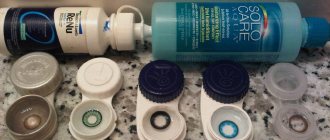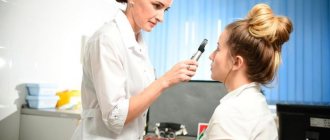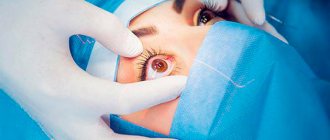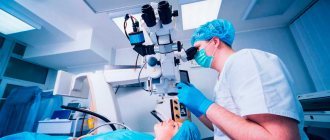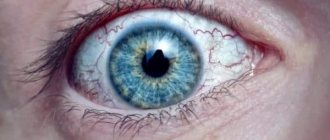Where will they be located and what will they look like?
There are 4 types of eyelid blepharoplasty. The stitch after will depend on the type of operation.
Classical
In lower eyelid blepharoplasty, an incision is made under the edge of the eyelashes or on the inside of the eyelid. The placement along the line of natural folds and the application of cosmetic sutures intradermally make the sutures very thin and almost invisible.
When performing an upper eyelid surgery, the doctor makes an incision in the supraorbital fold, where the skin is attached to the muscle that lifts the eyelid, then the excess skin is excised and excess fatty tissue is removed. Thus, scars after upper blepharoplasty are located in the natural folds of the upper eyelids.
Transconjunctival
It is carried out through an incision on the conjunctiva, that is, from the inside of the eyelid. This method allows you to avoid the formation of scars on the skin, being seamless, because the mucous membrane is well restored and there is no need to use suture material.
Laser
This method of eyelid surgery is non-surgical. The surgeon does not make any incisions on the skin. Instead, the areas of skin that need correction are targeted to a laser beam. New skin quickly appears on the treated areas.
The visible effect can be observed within a week after the procedure, but the process of skin cell renewal will continue for about another month.
Asian eyelid surgery "Singapore"
During the operation, the surgeon removes the epicanthus in the inner corner of the eye, excising the skin and removing excess fatty tissue, creating a double semicircular fold on the upper eyelid and applying sutures. Singaporei without incisions can be performed if the patient has slight drooping eyelids.
In the upper eyelid, the surgeon, using suture threads, creates invisible sutures along special muscle aponeuroses, which subsequently look like a natural double fold.
Formation of edema after blepharoplasty
The skin of the eyelids is the thinnest part of the body. Therefore, after surgery, bruises and swelling occur on it . The reason lies in the accumulation of fluid in injured tissues.
This result is possible even with an endoscopic procedure. A few millimeter punctures are enough to increase the permeability of blood vessels, compress the lumen and venous tissue, which prevent the normal outflow of blood and lymph.
We recommend reading: Rehabilitation after blepharoplasty
On the lower eyelids
Such a reaction cannot be avoided; perhaps only a change in severity. More extensive swelling appears after traditional blepharoplasty if transconjunctival intervention was performed - the congestion is not as pronounced, since the doctor touches fewer vessels during the operation .
On the upper eyelids
The dermis of the upper mobile skin is more vulnerable. The swelling after surgery is almost unnoticeable, but lasts longer because the area is less supplied with blood.
Puffiness occurs to varying degrees in each eye. A characteristic reaction also begins during endoscopic surgery.
The permeability of arterial vessels increases sharply, and moisture leaves the bloodstream into the interstitial space. The accumulated fluid puts pressure on the lumen of small veins and lymphatic vessels, creating an obstacle to the outflow of venous blood and lymph.
Sometimes the swelling spreads to neighboring areas - the area around the eyes, other areas of the face.
What happens to the sutures immediately after surgery?
At the end of the operation, a bandage will be applied to the stitches. Swelling, like bruising, cannot be avoided, and its severity varies among patients. In a few days they will begin to pass. It is important to ensure the drainage of lymph; to do this, it is enough to lie on your back so that your head is higher than chest level. Cold compresses, as recommended by your doctor, can also provide relief.
The stitches are removed no earlier than after 3-7 days, then a special patch is applied to the scar line for about 3 days, and after 4 days all stickers are removed. When using self-absorbing threads, this is not required; they will disappear on their own.
After surgery, you may need to take painkillers. The area around the scars will be especially sensitive for about a week.
Scars are actively forming at this time and are red in color, as new tissue and blood vessels are being formed. Soon they will begin to become lighter. All necessary manipulations for treatment and dressing during this period are performed by a surgeon or nurse.
Caring for seams
I think you have a general idea about caring for seams. In most cases, the algorithm of actions is the same and simple.
As with any other plastic procedure, after blepharoplasty the doctor applies a sterile dressing to the stitches.
At the same time, experts recommend applying cold compresses to the affected areas. This will reduce swelling.
You will be allowed to wash your face only the next day. And cold water. And so that the bandage and stitches remain dry.
Next, if everything is fine with the stitches, the doctor will either remove the stitches, or (if the threads are self-absorbing) will tell you in detail what will happen to them.
In addition, the specialist will explain how to treat seams at home.
To speed up the healing process, special ointments and creams may be prescribed.
It is important here not to self-medicate. Use only medications approved by your surgeon.
General recommendations from doctors
During this period, it is strictly forbidden to touch the eyelids, pull or scratch them. This rule must be strictly observed, otherwise you can get unaesthetic scars, cause infection, cause enlargement, compaction at the suture site, and a change in its color.
Therefore, immediately after the operation you should not use contact lenses, but you should wear glasses during this period, which will not only help correct your vision, but will also hide the traces of the operation if the glasses are darkened.
You should refrain from using any cosmetics for about two weeks.
On this topic
- Blepharoplasty
What not to do after blepharoplasty
- Editorial board of Plasticology.ru
- October 21, 2020
During rehabilitation, it is important to avoid exposure to direct sunlight, otherwise it may cause pigmentation of the scars. You should wear sunglasses outside for two months, and after that you can use sunscreen for the skin around your eyes.
For about two months after eyelid surgery, you should avoid visiting baths and saunas, as well as taking a very hot bath. It is important to limit eye strain when reading or working at the computer. Do not perform heavy physical work around the house or at your dacha, and also postpone playing sports for a while.
Do not ignore bed rest in the first days after eyelid correction. During the postoperative period, you should sleep on your back, so that your head is located higher than your chest, this will ensure the outflow of lymph and allow you to quickly get rid of swelling.
Wash your face with boiled water at room temperature or with herbal infusion. Cold compresses may be applied to the eyes for several days after surgery.
Drinking alcohol and smoking during the recovery period are strictly prohibited. You should also exclude very salty foods from your diet, which can cause swelling that stretches the skin.
How long does it take for stitches to be removed?
After the operation, the patient is under the supervision of doctors for a day, after which he can go home. The stitches are usually removed after 3-7 days. According to patients, the procedure is quite tolerable.
If after some time the patient suddenly notices an absorbable thread or nodules appearing out, he needs to see the operating surgeon. You cannot pull out the threads or massage your eyelids yourself.
After the sutures are removed, scars begin to form. The area around the scars will be especially sensitive for about a week. For about a month, at the site of the sutures, new connective tissue is formed, penetrated by many small vessels.
On this topic
- Blepharoplasty
Circular blepharoplasty
- Editorial board of Plasticology.ru
- October 18, 2020
If immediately after blepharoplasty the seams were red, then by the end of the first month they become pink, noticeably paler. During the second month, the scar takes on the appearance of a thin, smooth white line. The timing is always individual, but on average, traces of plastic correction should disappear in two to three months.
It happens that the recovery process is delayed. In this case, it is better to contact the surgeon who performed the operation to avoid or eliminate the growth of excess connective tissue. Timely treatment will allow you to limit yourself to conservative methods (using ointments or undergoing physiotherapeutic procedures), without resorting to operating rooms.
Healing process
The healing process of sutures after blepharoplasty involves several stages. The first period of wound healing lasts 2-7 days. At this time, it is necessary to support the edges of the wound so that the fusion is as accurate as possible.
The second period lasts 2-4 weeks. During this time, the granulation process takes place in the wound - new bright pink connective tissue is formed. The patient should not be intimidated by the color, since granulation is only the second stage of healing. On the recommendation of a doctor, you can do cosmetic procedures:
- lymphatic drainage;
- magnetic therapy;
- microcurrent therapy.
If at the time of healing the patient notices that the blepharoplasty sutures are strongly tightened, then physiological procedures are necessary. This will help get rid of unwanted consequences. The third period is scarring.
At this stage, ugly scars do not appear. On the contrary, granulation tissue is replaced by epithelial tissue, and the postoperative suture turns into a thin light pink strip, which is almost invisible in the natural crease of the eyelid.
The duration of the third period is 1-4 months. At the end of this period, you can do laser resurfacing of the seams and Botox injections. Laser resurfacing allows you to completely eliminate the cut line. Botox injections smooth out wrinkles that have not yet gone away after eyelid correction surgery.
We recommend: When is blepharoplasty necessary?
How to process and what to smear
If the recovery process after surgery proceeds as usual, there is no need to use healing accelerating agents; the body will cope with everything on its own.
Experts advise treating the seams with Chlorhexidine or fresh chamomile decoction, performing light and stroking movements with a cotton swab, without putting pressure on the scars.
There is no need to coat the seams after blepharoplasty. And for the eyes, for preventive purposes, antiseptic drops are prescribed. The need to use other medications, if necessary, is determined only by a doctor.
If a patient has a tendency to form keloid scars, it is important to warn the surgeon about this so that he can select medications that prevent the formation of excess connective tissue.
Why might seams come apart?
In fact, there are not many reasons:
- violation of the patient's daily routine. If you engage in physical activity, the stitches after blepharoplasty may come apart;
- low quality suture material. If the surgeon uses a very thin or weak thread, it may break on its own and the suture will come apart;
- poor tissue support. If, after suturing, the ends of the thread are poorly fixed or not secured at all, then the seam may come apart due to insufficient fixation.
If after blepharoplasty the seam comes apart, you need to contact your doctor for reapplication. Otherwise, the wound may become inflamed, which will worsen the recovery process. even a small discrepancy will turn into a large and unsightly scar after healing.
We recommend: What are the pros and cons of blepharoplasty?
It will have to be corrected by laser resurfacing or surgery. Even if a good blepharoplasty was done, resurfacing of the seams may still be required. This is characterized by the peculiarities of wound healing, and nothing depends on the surgeon here.
With circumferential and lower blepharoplasty, the outer edge of the eye is often attached. This helps prevent the lower eyelid from drooping after the sutures are fully tightened. If the patient notices that the suture supporting the outer corner of the eye has become weak, it is necessary to notify the surgeon.
Possible complications after suturing and ways to correct them:
- swelling. This is a normal phenomenon of the operation and no treatment is required. You need to use cold compresses and choose only the right position at the time of sleep: your head should be on a hill. Postoperative swelling disappears 1-2 weeks after surgery;
- bruises. The reason for their appearance is the touching of blood vessels at the time of the incision or during stitching. Small hematomas completely go away on their own 1-3 weeks after surgery. If the hematoma is large, surgery may be necessary. Only with a large hematoma is surgery required, which is extremely rare;
- seam divergence. It can appear due to many reasons: both through the fault of the surgeon and through the fault of the patient if he does not follow the recommendations. The wound will not heal neatly without a properly applied suture. Re-suturing is required;
- dryness of the mucous membrane of the eye. Appears due to partial closure of the eyelids. The symptom may go away on its own. Moisturizing drops must be used. No surgery required;
- partial closure of the eyelids. The cause may be either severe tissue swelling or the excision of too much skin during blepharoplasty. This phenomenon will go away on its own after the swelling goes away, if partial closure of the eyelids is caused by tissue swelling. Surgery is only necessary if the eyelids are partially closed due to excessive skin excision;
- inversion of the lower eyelid. The reason is excess skin removal, natural drooping of the lower eyelid due to weakened tissues and ligaments. Repeated correction surgery is required;
- eye asymmetry. All people are asymmetrical, but the surgeon must take this into account. The asymmetry is present before the operation and after it it is more noticeable. The asymmetry will probably go away on its own within 2-4 months after surgery due to the complete disappearance of swelling and wrinkling of the skin. 6-8 months after the operation, the asymmetry becomes more pronounced; a repeat procedure must be done;
- scars and keloids. Appears with poor wound healing and decreased collagen formation. It is impossible to eliminate this on your own, but you can try using ointments, laser resurfacing, and administering medications based on hyaluronic acid. Repeat surgery is often required.
Now you know when sutures are removed after blepharoplasty, and what needs to be done for a full recovery.
YouTube responded with an error: The request cannot be completed because you have exceeded your quota.
Rate this article:
- Related Posts
- What to do if there are hernias left after blepharoplasty?
- Is it possible to have blepharoplasty?
- Where is blepharoplasty performed?
- What tests are needed for blepharoplasty?
- What are the contraindications to blepharoplasty surgery?
- What is the age limit for blepharoplasty?
How to speed up scar healing
Special silicone-based gels can help make scars smoother and lighter. If scar smoothing occurs too slowly, the surgeon may recommend removal of excess connective tissue, or revision.
Very often, doctors advise patients to perform special gymnastics for the eyes. Special exercises restore activity to the eye muscles, stimulate blood circulation, and ensure lymph movement. As practice shows, performing such gymnastics allows you to speed up the disappearance of hematomas and quickly cope with swelling.
Physiotherapeutic procedures, for example, myostimulation, will help reduce recovery time. During this procedure, the facial muscles receive micro-shocks of low-frequency electric current, causing muscle contractions.
Some cosmetic procedures can speed up the healing of scars by shortening the recovery period. Lymphatic drainage massage, soft peelings, complex procedures aimed at moisturizing and tightening the skin have a noticeably pronounced effect, making the face smooth and elastic.
On this topic
- Blepharoplasty
Pros and cons of plastic surgery for eye enlargement
- Editorial board of Plasticology.ru
- July 8, 2020
However, you should not use them immediately after surgery; you need to wait until the skin in the area of the scars recovers.
Complete healing of the skin after surgery will occur no earlier than 3-6 weeks. Intradermal administration of hyaluronic acid preparations is also not recommended for use earlier than a month after plastic surgery. The need to repeat blepharoplasty occurs no less than 10-12 years later.




